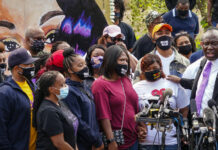It looks like more stimulus relief may be coming to help offset the economic effects of the coronavirus pandemic. But discussions on another stimulus bill likely won’t start until at least late July, after Congress returns from recess.
Members of both the Senate and the House of Representatives are expected to return to Washington on July 21. That’s just 10 days before some of the benefits enacted under the CARES Act, like increased unemployment insurance payments, are set to expire.
So, what will happen to those additional unemployment benefits? And could a second stimulus check, additional student loan debt and unemployment benefits and small business aid be included in the next stimulus package? Here’s where each of those stand.

A second stimulus payment is possible if Congress passes another stimulus package.
Alexander Mils for Unsplash
Additional Unemployment Benefits
Currently, Americans who are out of work as a result of the pandemic are eligible to get an additional $600 a week, as part of the CARES Act passed in March. But those enhanced benefits are set to expire on July 31.
What could happen next?
It’s still unclear, but there are indications that some additional aid for the unemployed may be included in another stimulus package. When May’s job report came in much better than expected—with employment increasing by 2.5 million and the unemployment rate falling to 13.3 percent from 14.7 in April—that put an extension of supplemented unemployment payments and additional stimulus payments into question.
But then William W. Beach, the Commissioner of the Bureau of Labor Statistics, which compiles the jobs data, clarified that not all workers who were absent from work due to coronavirus-related business closures were counted in the unemployment numbers. Had they all been classified as unemployed on temporary layoff instead, the unemployment rate would have been 16.3 percent, not the official rate of 13.3 percent. (The Bureau of Labor Statistics said it is taking steps to address the data collection error.)
On Wednesday, Federal Reserve Chair Jay Powell also painted a less rosy picture, warning that the country could see higher unemployment for awhile. The central bank projects unemployment will fall to 9.3 percent by the end of this year and to 6.5 percent by the end of 2021, but those levels are still much higher than in recent years. Powell also stressed that more aid from Congress (and from the central bank) will likely be needed and indicated the central bank could maintain interest rates near zero through 2022.
There are reports that the White House is considering an extension to additional unemployment payments, but lowering them to $250 or $300 a week. The idea is that the reductions will incentivize people who lost their jobs to seek work. That would also address concerns that some who lost their income are now making more money from their unemployment benefits than they did from their former jobs. (As many as 68 percent of laid-off workers are in that group, based on estimates by University of Chicago researchers.)
President Donald Trump confirmed in June 5 remarks that the White House “will be asking for additional stimulus money.” And he has specifically cited changes to unemployment benefits among the administration’s proposals.
A Second Stimulus Payment
Given concerns about higher unemployment continuing through next year, including another stimulus payment in any stimulus package is also a possibility.
Support’s growing for a second stimulus check
In Senate testimony on Wednesday, Treasury Secretary Steven Mnuchin said: “I think we’re going to seriously look at whether we want to do more direct money to stimulate the economy.”
The next day, Mnuchin added that the administration’s “very seriously considering” a second round of stimulus checks, according to The Wall Street Journal.
How much would a second stimulus payment be?
The HEROES Act, which was passed by the House of Representatives, offers the possibility of a larger second stimulus payment than the CARES Act provided. Under the new legislation, each household member would get $1,200, including children. The income thresholds would stay the same, meaning single taxpayers earning less than $75,000 and married taxpayers earning a total of $150,000 would receive the full payments. So, a family of four with parents who earned less than $150,000 in 2019 would get $4,800. (The HEROES Act would cap total payments at $6,000 per family.)
But Republican senators, who hold the majority, have indicated that they are unlikely to pass the HEROES Act as is, and will be discussing new proposals. So, if a second round of stimulus payments are included, the amount and who’s eligible could change. Either way, it will likely be a one-time stimulus payment—not the series of payments that Sen. Kamala Harris (D-CA), Sen. Bernie Sanders (I-VT) and Sen. Ed Markey (D-MA), proposed with the Monthly Economic Crisis Support Act.
Small Businesses Stimulus Relief
In a hearing this week, Chairman of the Small Business and Entrepreneurship Committee Sen. Marco Rubio (R-Fla.) said 4.5 million businesses have received more than $500 billion in loans through the Paycheck Protection Program and that without it “tens of millions of Americans would have been permanently separated from their livelihoods.”
Over $130 billion remains untapped in the second round of funding though, so Congress has loosened the rules a little. It voted to extend the period in which the funds must be spent from eight to 24 weeks, for example. And borrowers must now spend at least 60 percent of their funds on payroll (instead of 75 percent) to have their loans forgiven. That should allow more flexibility to use the loan money on other business expenses, like utilities and rent.
Despite the billions in aid that haven’t yet been used, Sen. Rubio gave his support for an additional legislative stimulus package, saying restaurants and hotels in particular seem to be in need of more aid. “I definitely think we are going to need another bipartisan legislation to put more money into the economy,” he said.
More Student Debt Relief
The HEROES Act that passed the House had many provisions that would offer relief for student loan borrowers, including some student loan debt forgiveness (though an amendment did restrict who could qualify for student loan forgiveness).
They included:
- $10,000 in federal student loan forgiveness for borrowers in default, delinquent or have deferred loans due to economic hardship
- $10,000 in private student loan forgiveness for “economically distressed” borrowers
- An extension of the suspension of payments and interest on government-held federal student loans through September of 2021
But it’s unlikely that the Senate will pass these provisions as is, especially as student loan forgiveness has proven a source of contention. That said, it’s possible that eligible borrowers would see an extension of the suspension of payments if another stimulus package is passed.
Many experts have warned that student loan delinquencies and defaults will rise if borrowers have to resume payments in October, when the extension enacted by the CARES Act expires.
“The payment pause and interest waiver should be extended because the disruption is ongoing and the recovery will be sluggish,” Mark Kantrowitz, a student aid expert and publisher of Saving for College, told CNBC.
Many student loan borrowers were already struggling with payments even before the coronavirus pandemic sent the economy into a tailspin. The total share of student loan debt defined as seriously delinquent (meaning accounts that are 90 or more days late on payments) was nearly 8.9 percent in the first quarter of 2020, the highest of any household debt category. Outstanding student loan debt has outpaced both credit card and auto loan debt over the last decade, and student debt rose by an additional $27 billion in the first quarter.
Student debt relief remains a big issue for voters. In a new survey by Laurel Road, a national lending company offering student loan refinancing, more than three-quarters of Millennial & Gen-Z respondents said the issue of student debt forgiveness will be somewhat or very influential in terms of who gets their vote in the upcoming primary and Presidential elections. And 83% of respondents said how candidates address the rising costs of higher education would influence their vote in the Presidential election in November.
Related Articles
Student Loan Debt Relief: What Are Your Options Now?
Will I Owe Taxes on My Stimulus Payment?
No Stimulus Check Yet? Here’s How to Determine When It May Arrive






